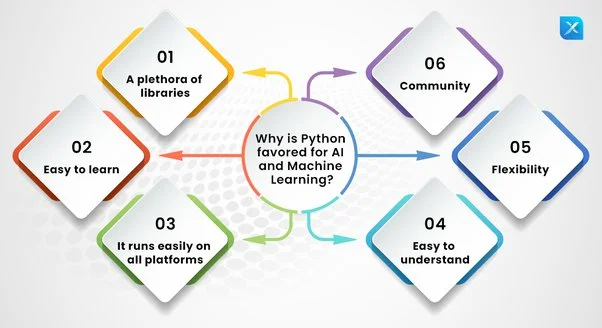Artificial intelligence (AI) and machine learning (ML) are two of the most exciting and rapidly evolving fields in computer science today. They have the potential to transform various domains such as healthcare, education, entertainment, and more. However, developing AI and ML applications is not an easy task. It requires a lot of skills, knowledge, and creativity from the programmers. That’s why choosing the right programming language is crucial for AI and ML development.
Among the many programming languages available today, Python stands out as one of the most popular and widely used ones for AI and ML projects. According to a survey by JetBrains, Python is the most preferred language for data analysis, machine learning, web development, and scripting . But what makes Python so appealing for AI and ML programmers? In this blog post, we will explore some of the reasons why Python is the perfect choice for AI and ML development.
Rapid Prototyping Abilities in Python
One of the main advantages of Python is its rapid prototyping abilities. Python allows programmers to write code quickly and easily, without worrying about complex syntax or compilation errors. This enables them to test their ideas and algorithms faster and more efficiently. Python also has a large number of libraries and frameworks that provide ready-made solutions for common AI and ML tasks, such as data processing, visualization, modeling, testing, and deployment. Some of the most popular libraries and frameworks for AI and ML in Python are:
- NumPy: A library for scientific computing that provides high-performance multidimensional arrays and mathematical functions.
- Pandas: A library for data analysis and manipulation that offers data structures and operations for manipulating tabular data.
- Matplotlib: A library for creating static, animated, and interactive visualizations in Python.
- Scikit–learn: A library for machine learning that provides various tools for data preprocessing, feature extraction, model selection, evaluation, and more.
- TensorFlow: A framework for deep learning that allows programmers to create and train neural networks using a high-level API or a low-level API.
- PyTorch: A framework for deep learning that offers dynamic computation graphs, automatic differentiation, distributed training, and more.
- Keras: A high-level API for deep learning that runs on top of TensorFlow or other backends, and simplifies the creation of neural networks.
- spaCy: A library for natural language processing (NLP) that provides various components for tokenization, tagging, parsing, named entity recognition, etc
3. Comprehensive Visualization
Data is one of the most important aspects of AI and ML development. Programmers need to be able to visualize their data in order to explore it, analyze it, detect patterns, and derive insights from it. Python offers a comprehensive set of tools for data visualization that can help programmers create stunning and informative graphs, charts, plots, and more. Some of the most popular tools for data visualization in Python are:
- Seaborn: A library for statistical data visualization that provides a high-level interface for drawing attractive and informative plots.
- Plotly: A library for interactive data visualization that allows programmers to create and share web-based plots that can be embedded in websites or notebooks.
- Bokeh: A library for interactive data visualization that enables programmers to create and display dynamic and interactive plots using web browsers.
- Dash: A framework for building web applications for data visualization that combines Plotly, Flask, and React.
- Streamlit: A framework for building data apps for data visualization that allows programmers to create and deploy interactive web apps with minimal code.
These tools allow programmers to create beautiful and interactive visualizations that can communicate their data effectively and enhance their AI and ML projects.
2. Hassle-free Readability
Another reason why Python is preferred by AI and ML programmers is its hassle-free readability. Python has a simple and consistent syntax that resembles natural language. It uses indentation to structure the code blocks instead of curly braces or semicolons. It also avoids unnecessary keywords or symbols that can clutter the code. This makes Python code easy to read, write, understand, and debug. It also reduces the cognitive load on the programmers and allows them to focus on the logic rather than the syntax.
Python also follows the principle of “There should be one–and preferably only one–obvious way to do it” . This means that Python encourages programmers to use clear and concise code that follows common conventions and best practices. This improves the readability and maintainability of the code. It also fosters collaboration among programmers who can easily share and reuse each other’s code.
4. Flexibility in Terms of Language
Python is also a flexible language that offers multiple paradigms for programming. Programmers can choose between scripting-led programming or object-oriented programming systems (OOPS) depending on their preferences or needs. Scripting-led programming allows programmers to run their code interactively without compiling it first. This enables them to see the results immediately and make changes accordingly. OOPS allows programmers to create classes and objects that encapsulate data and behavior. This enables them to model real-world entities and concepts in their code.
Python also supports multiple inheritance, which allows a class to inherit from more than one parent class. This enables programmers to reuse existing code and avoid duplication. Python also supports multiple dispatch, which allows a function to behave differently depending on the types of its arguments. This enables programmers to implement polymorphism and generic programming in their code.
Conclusion:
Python is a powerful and versatile programming language that offers many benefits for AI and ML development. It has rapid prototyping abilities, hassle-free readability, flexibility in terms of language, comprehensive visualization tools, and availability of resources and tutorials. These features make Python an ideal choice for programmers who want to create innovative and impactful AI and ML applications. If you are interested in learning more about Python or AI/ML development, you can check out some of the resources mentioned below or enroll in some online courses or bootcamps that can teach you these skills.
If you have any doubts feel free to ask in the comments or in our WhatsApp community “WireUnwired”. Here we a huge group of professionals as well as like minded students who are preparing for various companies ,so we are damn sure that you will get your doubts resolved as well as will help others in their journey so that they can also succeed with you.
Until then keep WireUnwiring.
These are Articles
The 'BARBIE' phenomenon is not a cultural trend; it is a geopolitical asset shift. WireUnwired analyzes how returning US undergrads act as vectors for critical VLSI and AI transfer to India's deep-tech ecosystem.
TSMC's 2nm wafers are hitting $30,000. We used our Silicon Economics Calculator to analyze why Apple locked up all the capacity, and why NVIDIA is stuck paying $10,000 per chip.
The 20-year era of "Silicon-on-Plastic" is ending. We analyze the 3 critical reasons—Warpage, Speed, and the "Rectangular Revolution"—driving the shift to Glass Core substrates by 2026.
Apple has secured 100% of TSMC's 2nm capacity, marking the end of the 15-year FinFET era. We analyze why the transistor's shape had to change to Gate-All-Around (GAA).
A routine API outage at 4 AM exposed a critical flaw in my security research. I analyze why relying on "Real-Time Data" is a single point of failure and the mathematical fix for resilient pipelines.
On-Device AI Is Coming Sooner Than You Think
The era of "Cloud AI" is ending. We analyze how the "1-bit" revolution (BitNet) enables GPT-4 class models to run offline on phones, and why Google's controversial Tensor chip strategy was right all along.
Discover more from WireUnwired Research
Subscribe to get the latest posts sent to your email.









